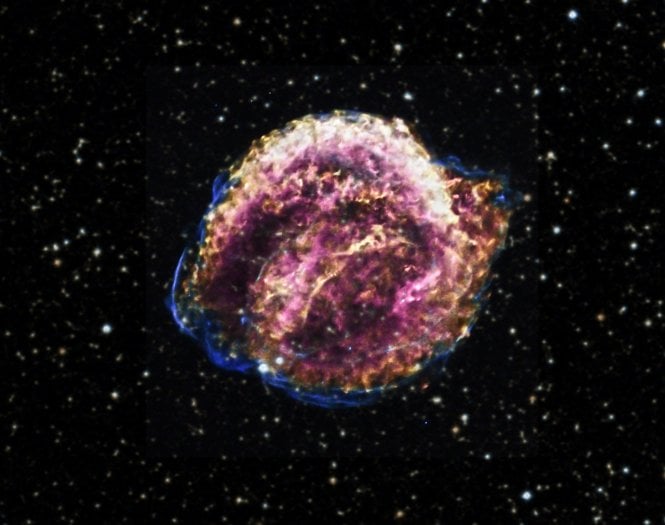A new study hints at a possible fascinating twist in human evolution. Did a chain of cosmic events triggered by a nearby ancient supernova force humans to walk upright?
The study, out earlier this year, points to an unlikely source for modern human bipedal locomotion: the effect on our environment of a nearby supernova or series of supernovae. The study, titled From Cosmic Explosions to Terrestrial Fires? was published in *The Journal of Geology*.
Galactic Bursts vs. Bipedalism
If the proposed mechanism that takes you from an exploding star to an upright human leaves you scratching your head, you're not alone. In a nutshell, the idea runs like this: A supernova detonates nearby—say within a 150 to 300 light-year radius of our solar system—showering Earth and the nearby vicinity with energetic cosmic rays. This, in turn, showers Earth's atmosphere with highly energetic particles, raising the frequency of lightning strikes.
Now, lightning is the biggest natural ignition source for wildfires. More lightning means more wildfires, accelerating the creation of treeless savanna. If you're hunting upright on the savanna, you have an advantage of seeing prey at a distance. This new environment would have selected for a random mutation allowing for our ancestors to run down prey. Along with our endurance (our ability to sweat), walking upright allows you to succeed on the savanna.
There is speculation that a gene mutation on chromosome 17 allows humans to walk upright. Of course, as with many adaptations in evolution, this comes at a cost, including all the maladies and back problems modern humans experience.
Lightning vs Cosmic Rays
The study cites an increase in the number of lightning strikes seen in carbon levels in the geological record, and an increase "(in the) iron-60 (isotope) at Earth, and the existence of the Local Bubble," researcher Adrian Melott (Department of Physics and Astronomy, University of Kansas) told Universe Today*, also citing the Nature 2016 paper, Supernovae in the Neighborhood.*
This enhanced rate of forest fires started in the geological record 7-8 million years ago. Humans were thought to have first walked upright around 6 million years ago. The study also cites an ancient supernova event 2 to 3 million years ago (the half life of Iron-60 is about 2.6 million years) that could be connected with an uptick in terrestrial wildfires.
Iron-60 found in deep sea floor deposits is a good indicator of ancient supernovae activity. Other suspect isotopes, such as Beryllium-10 and Plutonium-244 are contaminated by interaction with natural radiation and the Earth's atmosphere (in the case of Be-10) and 20th century nuclear weapons testing in the case of Pu-244.
The Local Bubble is a cavity of local space about 150 light-years in diameter, characterized by a density of neutral hydrogen about one sixth that of the galactic interstellar medium. The most recent event thought to have 'scooped out' this hollow is the ancient supernova that created the pulsar remnant Geminga, roughly 300,000 years ago.
Is the assertion correct? Certainly, the evidence is intriguing, though the logic needed allows for several steps to reach a conclusion. Cosmic rays are thought to trigger lightning, though this assertion is still debated. Ashley Hammond of the American Museum of Natural History notes in a recent *Popular Science* interview that there's evidence that bipedal evolution was already well underway, over four million years ago.
Supernovae come in two basic flavors: a Type 1 supernova, with two stars are in a tight binary pair: a main sequence star feeding material onto a white dwarf until it reaches a critical mass, and a Type 2 supernova, caused the collapse of a star 8-50 times as massive as our Sun.
Though we frequently see supernovae in other galaxies, such as the one we witnessed in the galaxy Messier 82 during the January 2014
You could say we're due.
There's also good evidence to suppose that nearby supernovae early in the solar system's youth seeded the early solar nebulae with heavy elements, notably Iron-60 and Nickel-60. Thankfully, there are currently no good supernova candidates in the 25 light-year radius 'kill zone' inside the Local Bubble… any good naked eye supernova will simply put on a good show.
With any luck, if Betelgeuse 'pops' in our lifetime, it won't go off in June, when it's on the far side of the Sun!
The aforementioned Nature study puts the odds of a kill-zone supernova near our solar system at once every 800 million years.
Will we ever know if we have an ancient supernova to thank for walking upright? Well, a modern galactic supernova could put the idea that it could influence rates of terrestrial lightning to the test.
"We are working on other effects that may be relevant," Melott told *Universe Today*, "But it will be a long time before anyone can sort out what caused what, as is usual in geology."
For now, it's fascinating to think that far away cosmic processes may well have shaped who we are today.
(Lead image: a recent supernova remnant (Messier 1: The Crab Nebula). Image credit and copyright: Nick Howes.
 Universe Today
Universe Today



